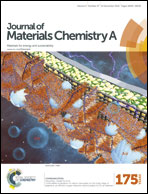Noble metal-free ultrathin MoS2 nanosheet-decorated CdS nanorods as an efficient photocatalyst for spectacular hydrogen evolution under solar light irradiation†
Abstract
Development of noble metal free, novel and highly efficient co-catalysts that favor high performance is of great significance towards elevated photocatalytic hydrogen production. The present existing technology for photocatalytic water splitting primarily involves the use of noble metals, such as Pt, as co-catalysts on semiconductor materials, resulting in significantly improved photocatalytic H2 production. However, because of the high cost and low abundance of Pt, its practical use is limited. In this study, we synthesized noble metal free, novel and highly efficient ultrathin MoS2 nanosheets-decorated CdS nanorods (UM/CdS) as a photocatalyst. We used a different and simple method instead of the usual preparation techniques for conversion of MoS2 to ultrathin MoS2; i.e. an ultrasonic method. Under optimized experimental conditions, the synthesized UM/CdS material exhibits an amazingly high rate of H2 production of up to 174 mmol h−1 g−1 under natural solar light irradiation. The ultrathin MoS2 nanosheets effectively separate the photo-generated charge carriers and improve the surface shuttling properties for efficient H2 production via the active edge sites. Furthermore, the present H2 evolution rate is much higher than that of noble metal (Pt) and bulk MoS2-assisted CdS photocatalysts individually. Moreover, to the best of our knowledge, this is the highest H2 production rate achieved by MoS2-based CdS photocatalyst through the splitting of water under solar light irradiation. Considering its low cost and high efficiency, this photocatalytic system would have great potential for the expansion of highly efficient photocatalytic materials used in various fields.



 Please wait while we load your content...
Please wait while we load your content...